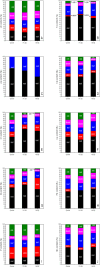Environmental risks and agronomic benefits of industrial sewage sludge-derived biochar
- PMID: 39687003
- PMCID: PMC11648124
- DOI: 10.7717/peerj.18184
Environmental risks and agronomic benefits of industrial sewage sludge-derived biochar
Abstract
The main objective of the present work was to assess the ecotoxicological safety of the use of thermochemically treated sewage sludge from the wastewater treatment plant (WWTP) of a distillery plant as a soil additive in agricultural soils based on its physicochemical characteristics and the bioaccumulation of selected elements in the plant tissues of maize (Zea mays). We have carried out physicochemical characterization (pH, EC, Corg, Cinorg, CEC, N, H, ash content, PAHs) of sewage sludge feedstock (SS) and sludge-derived biochar (BC) produced by slow pyrolysis at a temperature of 400 °C. The effect of 1% (w/w) amendment of SS and BC on soil physicochemical properties (pH, EC, Cinorg), germination of ryegrass, soil rhizobacteria and microorganisms, as well as on the accumulation and translocation of selected elements in maize (Zea mays) was studied. The results show that pyrolysis treatment of distillery WWTP sludge at 400 °C increases pH (from 7.3 to 7.7), Corg(from 28.86% to 36.83%), N (from 6.19% to 7.53%), ash content (from 23.59% to 50.99%) and decreases EC (from 2.35 mS/cm to 1.06 mS/cm), CEC (from 118.66 cmol/kg to 55.66 cmol/kg), H (from 6.76% to 1.98%) and Σ18 PAHs content (from 4.03 mg/kg to 3.38 mg/kg). RFA analysis of SS and BC showed that pyrolysis treatment multiplies chromium (Cr) (2.2 times), nickel (Ni) (2.96 times), lead (Pb) (2.13 times), zinc (Zn) (2.79 times), iron (Fe) (1.26 times) in the obtained BC, but based on an ecotoxicological test with earthworms Eisenia fetida, we conclude that pyrolysis treatment reduced the amount of available forms of heavy metals in BC compared to SS. We demonstrated by a pot experiment with a maize that a 1% addition of BC increased soil pH, decreased EC and Cinorg and had no significant effect on heavy metal accumulation in plant tissues. According to the results of the three-level germination test, it also does not affect the germination of cress seeds (Lepidium sativum). There was a significant effect of 1% BC addition on soil microbial community, and we observed a decrease in total microbial biomass and an increase in fungal species variability in the soil. Based on these results, we conclude that BC represents a promising material that can serve as a soil additive and source of nutritionally important elements after optimization of the pyrolysis process.
Keywords: Biochar; Carbon sequestration; Environmental risks; Fertilizer; Hazardous substances; Nutrients source; Potentially toxic metals; Pyrolysis; Sewage sludge; Soil additive.
©2024 Frišták et al.
Conflict of interest statement
The authors declare there are no competing interests.
Figures





Similar articles
-
Effect of biological sewage sludge and its derived biochar on accumulation of potentially toxic elements by corn (Zea mays L.).Sci Rep. 2024 Mar 12;14(1):5985. doi: 10.1038/s41598-024-56652-8. Sci Rep. 2024. PMID: 38472316 Free PMC article.
-
Application of biochar from sewage sludge to plant cultivation: Influence of pyrolysis temperature and biochar-to-soil ratio on yield and heavy metal accumulation.Chemosphere. 2014 Aug;109:213-20. doi: 10.1016/j.chemosphere.2014.01.070. Epub 2014 Feb 28. Chemosphere. 2014. PMID: 24582602
-
Sequential extraction of nickel and zinc in sewage sludge- or biochar/sewage sludge-amended soil.Sci Total Environ. 2018 Sep 15;636:927-935. doi: 10.1016/j.scitotenv.2018.04.072. Epub 2018 May 2. Sci Total Environ. 2018. PMID: 29729510
-
A critical review of the bioavailability and impacts of heavy metals in municipal solid waste composts compared to sewage sludge.Environ Int. 2009 Jan;35(1):142-56. doi: 10.1016/j.envint.2008.06.009. Epub 2008 Aug 8. Environ Int. 2009. PMID: 18691760 Review.
-
Comparison of pyrolysis process, various fractions and potential soil applications between sewage sludge-based biochars and lignocellulose-based biochars.Ecotoxicol Environ Saf. 2021 Jan 15;208:111756. doi: 10.1016/j.ecoenv.2020.111756. Epub 2020 Dec 8. Ecotoxicol Environ Saf. 2021. PMID: 33396079 Review.
References
-
- Ason B, Ababio FO, Boateng E, Yangyouru M. Comparative growth response of maize on amended sediment from the Odaw River and cultivated soil. World Journal of Agricultural Research. 2015;3:143–147. doi: 10.12691/wjar-3-4-5. - DOI
-
- Bouqbis L, Daoud S, Koyro HW, Kammann CI, Ainlhout LFZ, Harrouni MC. Biochar from argan shells: production and characterization. International Journal of Recycling of Organic Waste in Agriculture. 2016;5:361–365. doi: 10.1007/s40093-016-0146-2. - DOI
-
- Brtnicky M, Dokulilova T, Holatko J, Pecina V, Kintl A, Latal O, Vyhnanek T, Prichystalova J, Datta R. Long-term effects of biochar-based organic amendments on soil microbial parameters. Agronomy. 2019;9:747. doi: 10.3390/agronomy9110747. - DOI
MeSH terms
Substances
LinkOut - more resources
Full Text Sources
Research Materials
Miscellaneous

